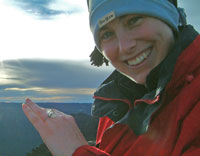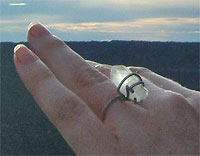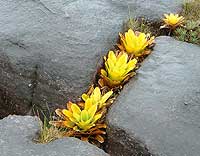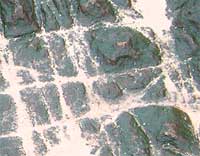People often ask me about the design process involved in a jewelry commission, so I thought I would document a recent example.
 Andrew proposed to Alex on the top of Mount Roraima in South America with a ring he made from a quartz crystal he found in a river bed.
Andrew proposed to Alex on the top of Mount Roraima in South America with a ring he made from a quartz crystal he found in a river bed.
When they returned from their travels Andrew asked me to design and make her engagement ring.
The following documents some of our correspondence about the ring design and includes renderings of the other designs we considered.
I felt the ring design should have some connection to Mount Roraima, so the first thing I did was to research the area. In particlular I was interested in whether any gems were mined there.
Amongst other less precious stones, Roraima produces fancy coloured diamonds. It struck me how befitting it would be to incorporate a diamond from Roraima in the design. However rough diamonds from different origins are often mixed prior to being sold on for cutting and polishing. This means that it can be very difficult to establish what has been called the "fifth C" - Country of Origin.
In my first e-mail to Andrew I suggested that we use their trek up Mount Roraima and/or his quartz crystal ring as inspiration for the design. I also mentioned the possibility of using a natural diamond crystal rather than a cut stone to reflect the quartz crystal ring he made for her.
Andrew's reply:
"..... I like the idea that the stone would have a more natural appearance. The crystal I found was a hexagonal rod of Quartz which came to a clean point at one end. They were quite amazing in the way they looked like they had been cut, but had formed naturally. I found it in a stream lined with crystals, which cascaded between the black rocks with a pink sand bed .... I was thinking about the way the top of Roraima was criss crossed with lines of erosion from the perpetual rainfall creating block like forms. In these ravines grew the bromeliads you see in one of the photos attached. Maybe such a block like form could hold the stone....."
 |
 |
 |
| Quartz crystal ring |
Ravines and bromeliads |
Rock errosion and pink sand |
The photos above show the quartz crystal ring Andrew made, yellow bromeliads growing between rock blocks and the strange rock formations on Mount Roraima. From these I rendered a number of designs for Alex's engagement ring...
Design 1: With Andrew's crystal ring in mind, the design above uses a round platinum wire setting to hold natural Octohedral Diamond Crystal. Natural Diamond Crystals are found in numerous different forms, cubes, spheres, dodecohedrans and octohedrons amongst others.
Design 2: Reflecting the yellow bromeliads they came across on their trek, this design incorporates a large yellow sapphire in a heavy walled setting. 22k gold striations crisscross the grey 18k palladium white gold ring shank.
Design 3: Here small yellow sapphires are set in ravines around the ring.
Design 4: Here again a natural octohedral diamond crystal is used, but this time held in a heavier setting. 18k pink gold striations across the band evoke those on the river bed where Andrew found the Quartz Crystal.
Andrew and I discussed these designs. He very much liked the idea of a diamond crystal in its raw form and was fairly confident that Alex would like it too. He prefered the heavy walled setting in design 2 and design 4, but didn't think mixing two colours of metal was Alex's style so we agreed to stick to platinum.
And so began the hunt for a suitable diamond crystal.
I had been able to find crystals from South Africa and Australia fairly easily. Alex was born in South Africa, so there was some link there, but what we really wanted was a crystal from Roraima. After literally months of searching we found a two suitably clean crystals through John Betts Fine Minerals in New York. One of them was a green sphere shaped crystal with natural sparkle and facinating crevices cut into its surface. Diamond crystals from the Roraima plateau are sometimes green to brown in colour due to exposure to natural radiation from uranium and thorium in their host rock.
I e-mailed Andrew a final design rendering showing how the green diamond crystal from Roraima would look set between two heavy platinum walls. I suggested a rounded ring shank rather than flat to compliment the spherical crystal. We also agreed that the ring and setting should be clean, crisp and polished in contrast to the rough diamond. Alex loves her engagement ring and the time and thought Andrew put into it's design makes it all the more special.
Click here to see the finished ring.